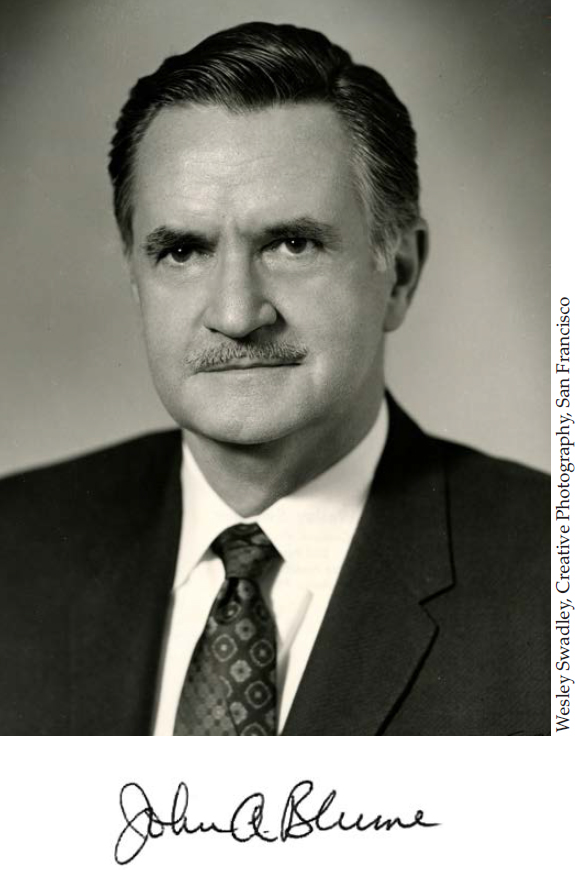JOHN A. BLUME
1909–2002
Elected in 1969
“Pioneering work in the development and application of new design concepts and analysis of buildings and structures in response to earthquakes.”
BY ANNE KIREMIDJIAN, JAMES GERE, HELMUT KRAWINKLER, AND HARESH SHAH
JOHN AUGUSTUS BLUME, an early pioneer in earthquake engineering and a consulting professor of civil and environmental engineering at Stanford University, died at his home in Hillsborough on March 1, 2002, at the age of 92. His wife Jene was at his bedside.
John Blume was born April 8, 1909, in Gonzales, California. He grew up hearing stories from both sets of grandparents about how they survived the great 1906 earthquake and fire. His father, Charles A. Blume, was a builder who participated in the reconstruction of the Palace Hotel and other buildings in San Francisco after the disaster.
As a young man, Blume worked for his father as a steel erector and rigger. In 1925 he witnessed the destruction of Santa Barbara by a magnitude 6.3 earthquake that killed 13 people and severely damaged the majority of commercial buildings. This experience was the impetus for his career in earthquake engineering.
Four years after the Santa Barbara earthquake, Blume enrolled at Stanford to study engineering and created a unique study plan—a mix of courses in geology, architecture, and
___________________
Reprinted with the permission of the John A. Blume Earthquake Engineering Center, Stanford University.
mathematics. He was awarded a BA degree with distinction in 1933 in civil engineering and an engineering degree in 1934. While at Stanford, he developed a close rapport with Lydik Jacobson, who introduced him to the study of structural vibrations and dynamics, which he later applied to the understanding of structural response to earthquake ground motion.
He began his career in engineering with the US Coast and Geodetic Survey and then joined Chevron Corporation and Brunnier Engineers of San Francisco. He participated in the design of oil refineries, buildings, and waterfront and other structures in the United States and around the world.
In 1945 he started his own company, which grew to become John A. Blume and Associates. Projects in which he was involved include buildings and waterfront structures for ARAMCO in Saudi Arabia, laboratory facilities for Chevron Research in California, the Stanford Linear Accelerator, the restoration of the California State Capitol, the Embarcadero Center Complex including the Hyatt Regency Hotel, the Diablo Canyon Nuclear Power Plant, and the Commercial Port for the government of Guam. In addition to the design of the Diablo Canyon plant, the firm provided earthquake engineering services to over 70 nuclear power plants in the United States, Japan, and Europe.
Blume also served as a consultant to the US Nuclear Regulatory Commission, and his firm monitored structural response to the underground nuclear weapons testing at the Nevada Test Site. In 1971 the company was acquired by URS Corporation, which operated under the name URS/John Blume and Associates.
In 1964, at the age of 55, Blume returned to Stanford to pursue his doctorate. He studied with Donovan Young and received his PhD degree on January 6, 1967, 33 years to the day after receiving his bachelor’s degree. His engineering practice continued to thrive while he was a full-time doctoral student.
John Blume was a strong proponent of earthquake engineering and is considered by many in the profession the “father of earthquake engineering.” He authored more than 150 papers, articles, and books, and was active in professional
organizations, helping establish many of them. He was a founding member and elected fellow of the Earthquake Engineers Research Institute (EERI) and served as president of the Structural Engineers Association of Northern California (SEAONC), Structural Engineers Association of California (SEAOC), EERI, and the Consulting Engineers Association of California (CEAC). He led numerous committees in these organizations and was instrumental in crafting some of the early earthquake-resistant design guidelines that evolved into building code regulations. In recognition of his contributions, the American Society of Civil Engineers (ASCE), SEAOC, and the New York Academy of Sciences made him an honorary member.
In addition, he received many awards and honors, including ASCE’s Leon S. Moisseiff Award (1953, 1961, and 1969) and Ernest E. Howard Award (1962), and the Harry Fielding Reid Medal of the Seismological Society of America (1985). In 1969 he was elected to the National Academy of Engineering and named “Man of the Year” by the Building Industry Conference Board. He was also an elected fellow of the American Concrete Institute and the International Association of Earthquake Engineering.
John Blume demonstrated boundless generosity, and his love for learning is best described in his own words: “I sincerely believe that the most important thing you have learned beyond the basic laws of nature, mechanics, and materials is to teach yourself.” In the mid-1970s, troubled that Stanford, which once was the leader in structural dynamics research, did not have an earthquake engineering laboratory—while Berkeley, Caltech, and Illinois, among others, had major laboratories in this field—he helped establish and endowed the earthquake engineering center that bears his name. He also established a graduate fellowship and a chaired professorship in earthquake engineering. Through the years, he took a keen interest in the progress and growth of the Blume Center, and worked closely with the faculty and students pursuing his research interest until Parkinson’s disease prevented him from being fully active.
Dr. Blume will be remembered for his pioneering research, remarkable books, and lectures; for establishing a leading structural engineering design firm; for his generosity to Stanford; and, to those who were privileged to have known him, for his warm and charming personality.
He is survived by his wife Jene, sister Beverly, nephew and nieces, a stepson, and two stepgranddaughters.







